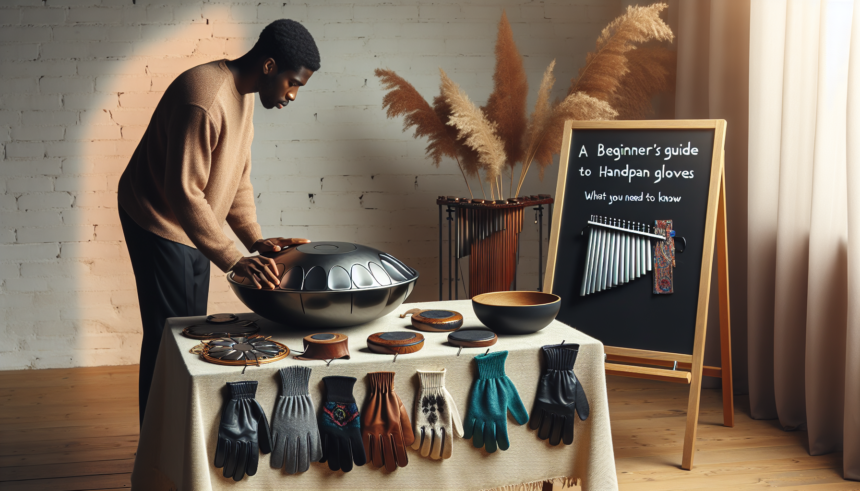<!DOCTYPE html>
<html lang="en">
<head>
<meta charset="UTF-8">
<meta name="viewport" content="width=device-width, initial-scale=1.0">
<title>A Beginner’s Guide to Handpan Gloves</title>
</head>
<body>
<article>
<p>Handpans have gained immense popularity over the years due to their unique, soothing sound and the meditative state they can induce in both the player and the listener. If you’ve recently embarked on the journey of playing the handpan, you may have heard about handpan gloves. These specialized gloves can be beneficial for various reasons, but as a beginner, you might have a lot of questions. This guide will help you understand what handpan gloves are, their benefits, and how to choose the right pair.</p>
<h2>What Are Handpan Gloves?</h2>
<p>Handpan gloves are specially designed gloves used by handpan players to improve grip, protect the instrument, and prevent hand fatigue. Made from materials that enhance tactile sensitivity, these gloves offer a good balance between protecting your hands and maintaining the delicate touch required to play the handpan effectively.</p>
<h2>Why Use Handpan Gloves?</h2>
<p>Here are some common reasons why handpan players choose to use gloves:</p>
<ul>
<li><strong>Protection for Your Hands:</strong> Continuous playing can lead to calluses or blisters. Handpan gloves provide a protective barrier.</li>
<li><strong>Instrument Care:</strong> Handpans are usually made from nitrided steel or some other metallic materials that can be susceptible to rust when exposed to sweat and oils from your hands. Gloves help minimize this.</li>
<li><strong>Enhanced Grip:</strong> Some gloves come with grip-enhancing features that make it easier to strike the notes accurately, especially in humid conditions where sweat could make your hands slippery.</li>
<li><strong>Comfort:</strong> Gloves can help reduce the fatigue that often comes from long practice sessions.</li>
</ul>
<h2>Types of Handpan Gloves</h2>
<p>There are various types of handpan gloves available, each designed to meet specific needs. Here are some common types:</p>
<ul>
<li><strong>Fingerless Gloves:</strong> These gloves cover your palm while leaving your fingers free. They offer a good balance between protection and tactile sensitivity.</li>
<li><strong>Full-Finger Gloves:</strong> These gloves offer complete coverage, providing maximum protection but potentially reducing tactile sensitivity.</li>
<li><strong>Grip-Enhanced Gloves:</strong> These gloves feature special materials or textures in the palm area to enhance grip.</li>
<li><strong>Lightweight Gloves:</strong> These gloves are made from lightweight, breathable materials that offer a good compromise between comfort and protection.</li>
</ul>
<h2>Materials Used in Handpan Gloves</h2>
<p>The materials used in handpan gloves can significantly affect their performance and durability. Common materials include:</p>
<ul>
<li><strong>Leather:</strong> Offers excellent durability and grip but can be less breathable.</li>
<li><strong>Synthetic Fabrics:</strong> Often more breathable and flexible than leather, providing good comfort and moderate durability.</li>
<li><strong>Mesh:</strong> Highly breathable, making it a good choice for hot and humid conditions.</li>
<li><strong>Microfiber:</strong> Known for its soft texture and good tactile sensitivity, often used in lightweight gloves.</li>
</ul>
<h2>How to Choose the Right Handpan Gloves</h2>
<p>Selecting the right pair of handpan gloves involves several considerations:</p>
<ul>
<li><strong>Comfort:</strong> Ensure that the gloves fit well and that the material feels comfortable against your skin.</li>
<li><strong>Tactile Sensitivity:</strong> The gloves should allow you to feel the instrument’s surface adequately.</li>
<li><strong>Durability:</strong> Look for gloves made from high-quality materials that can withstand frequent use.</li>
<li><strong>Grip:</strong> Choose gloves with good grip features if you find your hands slipping while playing.</li>
<li><strong>Breathability:</strong> If you play in warm conditions, opt for gloves that allow airflow to prevent sweating.</li>
</ul>
<h2>How to Maintain Your Handpan Gloves</h2>
<p>Proper maintenance can extend the life of your handpan gloves. Here are some tips:</p>
<ul>
<li><strong>Cleaning:</strong> Follow the manufacturer’s instructions for cleaning the gloves. Some may be machine washable, while others require hand washing.</li>
<li><strong>Storage:</strong> Store your gloves in a dry place to prevent mold or mildew. Avoid exposing them to direct sunlight, which can deteriorate the material.</li>
<li><strong>Inspections:</strong> Regularly inspect your gloves for signs of wear and tear. Replace them if they become too worn out to provide adequate protection.</li>
</ul>
<h2>How to Play with Handpan Gloves</h2>
<p>Playing the handpan with gloves might feel different at first, but you'll get accustomed quickly. Here are some pointers to help you transition:</p>
<ul>
<li><strong>Start Slow:</strong> Begin by playing simple scales to get a feel for the gloves.</li>
<li><strong>Adjust Your Technique:</strong> You might need to slightly adjust your hand positioning or the force you use to strike the notes.</li>
<li><strong>Practice Often:</strong> Like any skill, practice will help you become more comfortable playing with gloves.</li>
<li><strong>Take Breaks:</strong> If your hands feel fatigued, take short breaks to prevent strain.</li>
</ul>
<h2>Common Misconceptions About Handpan Gloves</h2>
<p>There are a few myths about handpan gloves that deserve debunking:</p>
<ul>
<li><strong>Gloves Diminish Sound Quality:</strong> While it’s true that gloves can slightly alter the sound, well-designed handpan gloves are made to minimize this effect.</li>
<li><strong>Only Beginners Use Gloves:</strong> Many experienced players use gloves to protect their hands and extend the life of their instruments.</li>
<li><strong>Gloves Make Playing Uncomfortable:</strong> A well-fitted pair of gloves made from quality materials can be very comfortable and improve your playing experience.</li>
</ul>
<h2>Conclusion</h2>
<p>Handpan gloves can be incredibly beneficial for both beginner and seasoned players. They offer protection for your hands, help maintain the condition of your instrument, and can enhance your overall playing experience. Choosing the right gloves involves considering factors such as material, fit, tactile sensitivity, and grip. With the right pair, you can enjoy long, comfortable playing sessions while keeping both your hands and your handpan in excellent condition.</p>
<h2>FAQs</h2>
<h3>1. Are handpan gloves necessary for beginners?</h3>
<p>No, they are not strictly necessary, but they can provide added comfort and protection, especially if you plan on playing for extended periods.</p>
<h3>2. Can I use regular gloves for playing the handpan?</h3>
<p>While you can, it's not recommended. Handpan gloves are specifically designed to offer the right balance of protection and tactile sensitivity.</p>
<h3>3. How do I know what size handpan gloves to buy?</h3>
<p>Most manufacturers provide size charts that you can use to find the right fit. Measure your hand according to the chart before purchasing.</p>
<h3>4. Will gloves change the sound of my handpan?</h3>
<p>Well-designed handpan gloves aim to minimize any impact on sound quality. However, some slight alterations in the sound may occur.</p>
<h3>5. Where can I buy handpan gloves?</h3>
<p>You can find handpan gloves in specialized music stores, online marketplaces like Amazon, or from brands that specialize in handpan accessories.</p>
</article>
</body>
</html>A Beginner’s Guide to Handpan Gloves: What You Need to Know

Leave a comment




